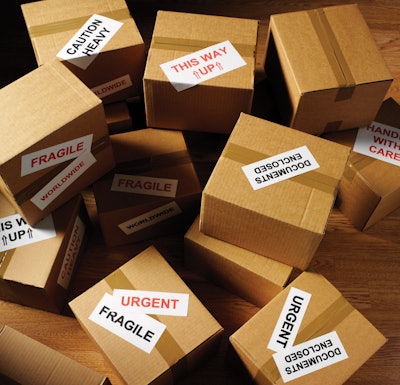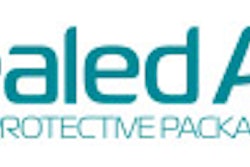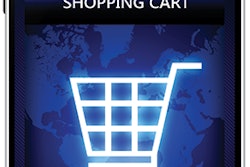As Packaging World established in Part I of our Special Report on E-Commerce, online grocery sales are growing rapidly, with market analysts predicting that between 2013 and 2018, online grocery sales will grow at a CAGR of 21.1%, reaching nearly $18 billion by the end of the forecast period. One of the major drivers of this shift away from brick-and-mortar sales—offline grocery sales are expected to rise by just 3.1% annually during the same period—is consumers’ desire for convenience.
Today, consumers can use any number of digital platforms to order grocery items for delivery direct to their doorstep or for pickup at local retail locations. But as much as consumers crave convenience, they are also very vocal—usually though social media—about their dislike of excessive packaging materials or packaging that is difficult to dispose of.
In a 2014 study from Sealed Air, “Packaging for E-Commerce Success," 34% of respondents said that the packaging a retailer uses for e-commerce shipping tells them about the company’s environmental policy and commitment based on the type and amount of packaging materials used. When asked about their pet peeves related to e-commerce packaging, 32% pointed to packaging that is difficult to dispose of (i.e., takes up too much space in the garbage, requires breakdown), and 27% said packaging that is difficult to recycle or is unrecyclable.
However, if a product arrives at their door damaged, 20% of respondents said they would never purchase from that retailer again. At the same time, consumers expect the same speedy, yet inexpensive, delivery of online orders they get from Amazon—two-day, overnight, and even same-day shipping, depending on the membership package.
So, how can e-commerce retailers find that sweet spot between protecting their product while using minimal and eco-friendly materials and still compete on shipping costs?
In Part II of this Special Report, we will explore some of the new packaging machinery and materials that have been introduced to help optimize the use of packaging materials, provide more sustainable options, and reduce shipping costs.
The dim-weight challenge
Despite most Consumer Packaged Goods companies’ most sincere altruistic intentions to minimize their environmental footprint, the bottom line for any business is cost. And this is no different for those selling products online. A particular challenge for those involved in e-grocery is the cost to ship lower-value products to consumers quickly while keeping costs down.
In the past, retailers were charged for freight based on the weight of a package. In 2014, many carriers introduced a new pricing method for freight called dimensional weight, or volumetric weight, pricing. Using this method, the length, width, and height of a box are multiplied together and divided by a dimensional factor (166 is standard) to determine the dimensional weight. This figure is then compared to the actual weight of the package, and the higher of the two is used to determine the base rate of the shipment.
So, for example, according to data gathered by Sealed Air, the cost to ship an 8-lb, 32-pack of toilet paper is $10.07, based on weight, and $13.81, based on dimension, resulting in a 37% increase in cost. For a 92-diaper box of Pampers Cruisers weighing 9 lb, the price by weight is $10.24, while the dimensional weight is $11.05—an 8% increase. With this in mind, packaging optimization is imperative for e-commerce retailers.
Says Principal of consulting firm Hudson Windsor and former Senior Director of Private Brands Packaging at Walmart Ron Sasine, “The current practice of using common-footprint delivery mailers and shipping cases for a broad diversity of products leads to mismatches, shipping inefficiency, and waste of both economic and material resources.
“Particularly challenging is the shipment of low-value items that are either extremely dense or extremely lightweight, both of which contribute to higher shipping costs either by weight or by volume. Think flour and paper towels. Both are regular necessities and ship very efficiently through commonly used channels yet are extremely tough to work with profitably in an e-commerce world.
“While the efficiency of buying and shipping relatively high-value items is the backbone of today’s e-commerce world, packaging innovation will be needed if we are to address products that don’t meet these characteristics.”
Shipping cases sized to fit
In the last several years, some of the largest e-commerce retailers, including Amazon and Staples (the second-largest e-commerce fulfillment business in the world after Amazon), have begun using new box-making technology that allows them to customize case sizes based on the exact size of the product(s) being shipped. This eliminates the need to warehouse multiple case sizes, reduces overpackaging, decreases or eliminates altogether protective packaging, and optimizes case sizes.
As of May 2015, Amazon had installed 20 Box on Demand machines (made by Italian manufacturer Panotec) in the U.S., and four between the U.K. and Germany, resulting in a 40% reduction in costs. Box on Demand and Panotec offer a range of software-driven BOD models that produce from four to 14 boxes/min from fanfolded corrugated board.
Says Panotec, “With a BOD machine working with fanfold, Amazon fulfillment centers are able to keep working and producing boxes all day long without any downtime, because the boxes are produced while the products are coming out of the warehouse. The operator no longer has to go looking for the right box for the product.
“This solution also allows them to save on packaging costs. With the BOD, there is no need to use void fill, such as packing peanuts and other cushioning materials. In addition, the amount of cardboard used by the machine is only the quantity needed to create the right-sized box; the square meters are already optimized to produce only the boxes they need.
“And last but not least, a right-sized box that perfectly fits the product inside also protects it better from damage during transport, ensuring products are delivered intact to Amazon’s customers.”
Another custom box-making machine that uses fanfolded stock is the On Demand Packaging® system from Packsize Intl. In 2012, Staples began deploying On Demand Packaging machines across its U.S. fulfillment centers in order to create a custom case size for every single less-than-full-case order it ships, or 40% of its order volume.
To ensure the machines keep pace with Staples’ order cycle times, the On Demand Packaging technology was adapted to interface with the company’s order management system to automatically calculate by way of an advanced algorithm the optimal box size for every incoming order and route it not just to the proper fulfillment system, but also to the most suitable machine at the distribution center.
Before employing the system, Staples used just four case sizes for its 12,000 SKUs, resulting in the need for air pillows to fill out the cases. With the addition of the On Demand Packaging system, the Staples Oak Creek, WI, facility, profiled in the March 2013 issue of PW, had reduced its average case size by 20% and its use of air pillows by 60% to 70%, resulting in an annual carbon footprint reduction of 320,000 tons, equivalent to approximately 120,000 trees.
Another box-making system designed specifically for e-commerce and fulfillment environments is the CartonWrap from Italian manufacturer CMC Machinery that creates corrugated boxes from a continuous roll of material at speeds to 10 boxes/min. The CartonWrap produces boxes in real time, with case sizes managed automatically through product recognition or directly from a database. The system can be expanded with printing systems that can add logos, trademarks, or other information directly onto the box, and labeling systems can be integrated according to shipping method needs.
From another Italian machinery manufacturer, System Packaging, a division of System S.p.A, comes the Freebox™, a robust box-making machine that uses two 48 x 48-in. sheets of corrugated to form custom boxes on-demand in up to 110,000 different box sizes and shapes at speeds to seven boxes/min.
A 2013 article in PW profiled the use of the Freebox by Door 2 Green Srl, the logistics and distribution arm of Italian ceramics giftware company Thun. At its Mantova, Italy, facility, the company was preparing to use the Freebox to create custom-size boxes for each of the nearly 7 million less-than-case-size orders that ship annually from the facility. Full implementation of the system required the completion of specialized software from System Packaging to calculate the volume of the items in each order to direct the machine in creating an optimized box size.
According to System Packaging, by using the Freebox, packagers can achieve savings from 7% to 36% in corrugated, depending on the box size, and can manufacture boxes with a 30% greater stacking strength and crush resistance, while using lighter-weight materials for the bottom panel of the box. Said System Packaging Product Manager Umberto Richichi in the 2013 article, “The savings in raw material is just a small part. Shipping, logistics, and labor also play a big part. Freebox has the potential to change logistics.”
Protective packaging options
While from a cost and sustainability perspective, the goal is to minimize packaging materials, it cannot be at the expense of product protection. Therefore, in those situations where it is required, protective packaging—used for void fill, cushioning, blocking, bracing, and wrapping—is essential.
In fact, as e-commerce shipping grows, so too will the demand in the U.S. for protective packaging, which—according to a study from The Freedonia Group entitled “Protective Packaging”—is forecast to expand 4.9% per year to $6.8 billion by 2019.
Mindful of consumers’ desire for greener e-commerce packaging, many protective packaging suppliers have introduced more sustainable alternatives to traditional materials. Among them are polyethylene air cushioning and bubble wrap made from recycled content; cornstarch-based, biodegradable packing peanuts; 100% renewable, recyclable, and reusable paper packaging; and 100% recycled-content, renewable, and recyclable molded pulp packaging—to name just a few.
In addition, new suppliers are introducing completely new solutions. For example, Ecovative has gained a lot of publicity for its mushroom root-based packaging, available from Sealed Air under the Restore® Mushroom® Packaging brand name. Used as an alternative to expanded polystyrene, the material is made from mycelium (the root-like structure of mushrooms), which binds agricultural waste into a strong, all-natural composite that offers high-performance cushioning. The material is filled into custom-designed forms, where it grows into its final shape, resulting in the right amount of protection with the least amount of material. Restore is completely biodegradable and home-compostable. One of the packaging’s most prominent users is computer giant Dell.
Replacing traditional paper, corrugated, and molded-pulp materials for protective packaging, YFYJupiter offers Npulp® created from the waste straw left behind from Chinese wheat and rice farming. In China, farm crops produce over 900 million tons of straw per year, which are typically burned off. Harvested two to four times per year, the material is rapidly renewable.
Npulp is produced through a proprietary enzymatic process that converts the straw into pulp in a one-hour process. Npulp is certified repulpable, recyclable, biodegradable, and compostable.
In 2014, Hewlett-Packard teamed up with YFY to use Npulp for its products. Explained Linda Chau, Director of Packaging & Media for HP Central Direct Procurement & Services, at the time of the announcement, “The process to create this packaging uses up to 40-percent less energy and 90-percent less water, emits 25-percent less CO2 than traditional methods, and helps reduce the company’s supply chain footprint. Moreover, since the packaging is lighter than wood-based molded pulp, it will cost less to ship.” Dell is also said to be using Npulp for its packaging.
LCA provides best path forward
According to a recent study from PMMI – the Association for Packaging and Processing Technologies titled, “2015 E-Commerce Market Assessment," the 55 key decision makers surveyed agreed that green packaging is here to stay. The question is how to make the financial and operational impact as positive as possible.
To address this challenge, PMMI reports that the industry has developed key factors and best practices that ultimately aim to view green packaging as a long-term investment that is best implemented with consideration of the entire life cycle and with ample due diligence. Among the considerations suggested by the PMMI report are whether the packaging can be rightsized, the usability of materials (e.g., does the label stick to the secondary material, will the tape adhere), and whether greener packaging will provide ample, durable protection.
“Another factor is to balance the consumer demand for green materials with the initial capital investment required,” the report continues. “While there is a short-term investment required, the return from consumer loyalty given this trend’s increasing popularity and demand will pay for the investment.”
In conclusion, one respondent, a sustainability manager from a logistics company, succinctly stated, “If sustainability means using no more material than you need and preserving the integrity of the contents, that is a cost-effective thing to do.”
Green innovation takes root with meal-kit companies
One market that seems to have been particularly creative in finding new eco-friendly protective packaging solutions is the meal-kit delivery market, which is expected to grow to $10 billion by 2020, according to a study from Technomic.
Among the first cook-at-home delivery services, New York City-based Plated switched from a corrugated shipper, an insulated plastic liner, and frozen gel packs for its meal-kit ingredients to a shipper made from 100% recycled fiber and recycled jute sacks, which replace the liner, in 2015.
The Jutebox jute sacks are supplied by TemperPack and are made from the discarded burlap bags used to ship coffee and cocoa. Using renewable materials, Jutebox sacks are said to emit just 0.23 lb of CO2 per pound of insulation when manufactured versus 4.5 lb for traditional polyurethane liners.
Another environmentally minded company, Kore Kitchen, announced in spring 2016 that it would be using glass and biodegradable packaging. The company’s biodegradable meal containers from Sabert are made from bagasse, a byproduct of sugarcane processing. Because it is not laminated, the container can break down quickly in any commercial compost. The containers can also go directly into the oven to warm meals. Kore Kitchen’s salad dressing containers, Greenware from Fabri-Kal are made of compostable polylactic acid made from corn that also breaks down in a commercial compost facility.
Also in early 2016, healthy, ready-to-eat meal-delivery service Freshly rolled out what it calls its “new, sustainable look, Freshly 2.0.” With the change, Freshly ditched its dry ice and expanded polystyrene for biodegradable, recycled denim and non-toxic, water-soluble, and recyclable gel packs.
Says Freshly CEO and co-founder Michael Wystrach, “We want our customers to feel good about the Freshly meals they’re eating as well as find comfort in the fact they’re using recycled and biodegradable materials. Freshly aims not only to help in the fight to eliminate food waste, but we also want to educate our customers on what it is they’re eating and what the packaging is made from.”
While Freshly has not named the supplier for its recycled denim material, one company currently supplying this product for packaging applications is Bonded Logic. Bonded Logic’s NaturalBlue™ provides both product protection and thermal insulation, and is available in a variety of encapsulation materials.
Online or offline shopping: which is more sustainable?
Recently released results of a study on the environmental impacts of online versus physical shopping behaviors shows that shopping at a mall has a 7% smaller environmental impact than online shopping. The study, detailed in the white paper “Does Shopping Behavior Impact Sustainability?,” was conducted by Deloitte Consulting on behalf of the Simon Property Group and used shopping data that represented consumer behaviors for mall and online shopping.
To understand the environmental impacts, the study created a cradle-to-grave Lifecycle Analysis that examined the environmental impacts of all material, energy, and fuels attributable to a product in its life cycle. The LCA also assumed the consumer purchased the same basket of goods online as they would in a brick-and-mortar location.
Findings from the research show that:
• Traveling to the mall in groups lowers the environmental impact per product bought. The average mall shopping group size is 2.2, and when people travel together and buy more products per trip, the average fuel burned to buy each product is lower.
• Shopping online leads to more returned products, which considerably increases the environmental impact. The data shows that 33% of online purchases are returned versus 7% in the case of brick-and-mortar.
• Packaging for online orders (corrugated boxes, bubble wrap, etc.) has a larger overall environmental impact compared with the impact of a plastic/paper bag consumers bring home from the mall.
“The difference in the environmental impact of shopping at physical stores versus online rests on a number of factors,” says Jason Mathers, Senior Manager - Supply Chain Logistics, for the Environmental Defense Fund. “As this paper makes clear, consumer choice about the number of items purchased, the likelihood of returns, and the ability to combine trips can help make shopping in-person the lower-impact choice.”
See Part III of Packaging World’s Special Report on E-Commerce Packaging, which will explore the impact of e-commerce on the graphic design of primary and secondary packaging, in the July 2016 issue.























